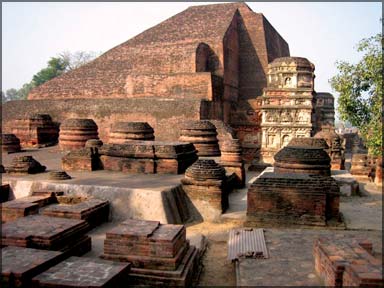Buddhist Nalanda
Oldest residential University of the world:
Edwin Ariyadasa
|

Nalanda University
|
To some holy tourists, visiting sacred sites in India, Nalanda may
not, at first, impress as a place, possessing a direct ‘Buddhist
significance. It is widely known as the site of the Nalanda University.
But it was a Buddhist University.
Besides, it was the oldest Residential University of the world. The
Stupa enshrining the Sacred relics of Ven. Sariputta, one of the Chief
disciples of the Buddha is located at this site, adjacent to the
university complex. This too makes it a Buddhist site.
We arrived at Nalanda from Rajagaha. Immediately our motor coach
stopped at the site, an interesting sight partly humorous - met our
eyes.
A group of urchins a ubiquitous tribe, frequenting tourist sites
displaying an admirable ingenuity, hastily staged a little drama. They
spread a mat by the side of the road. Some children sat on it. A
slightly elder child assumed the role of teacher and a class began.
After engendering interest in the visitors, they gathered round them.
They stated their grievance. “These children are keen to study. But,
they do not have the means. Can the visitors please help?” They enacted
this minor play, fully aware that visitors to Nalanda would have a
keenness for education.
The significance of the name Nalanda is variously interpreted.
According to one etymological explanation, Nalanda implies the given of
knowledge (‘Nalan’ is lotus, ‘da’ is giver, lotus is symbolic of purity
- pure knowledge). Others describe it as ‘non-stop giving’ (Nalan - non
- stop, da - giving).
Nalanda, which has been called ‘one of the first great universities
in recorded history,’ existed from 427 to 1197 AD.
In the days of the Buddha too, Nalanda had a reputation as a centre
of learning. When the Buddha visited Nalanda, his favourite place of
residence was Pavarika’s Mango Grove. He had philosophic dissensions
with house-holder Upali, Digatapassi and with Kevatta.
Nalanda Buddhist Residential University accommodated over 10,000
students in its heyday and had a faculty of about 20,000. It was a
massive and complex structure and was reputed as an architectural
marvel.
It was protected by a lofty wall with one gate. Nalanda was organised
in separate compounds and ten temples. Its functional efficiency was
ensured by meditation halls, lecture rooms, storage facilities, stages,
refectories. The complex included lakes and parks.
The University had four door - ways. Each of these was presided over
by a learned Professor - described as ‘The Professor at the Door’ (dvara-acharya).
A scholar seeking entrance to The University, will be extensively
examined by the Professor at the Door. If he is happy about the
scholars’ potential to benefit for the University, he will be admitted.
It was literally ‘an Entrance Test’.
Hardly anyone was turned away. If it was felt that given scholar was
wanting the expected skills, he will be directed to an Auxiliary
Institution. With sufficient intellectual maturity he will receive
placement at the main University. Scholars from Tibet, Korea, Japan,
China, Indonesia, Persia and perhaps from Sri Lanka too, sought
admission.
Its academic curriculum included all fields of knowledge in the
contemporary world - Buddhism, Hinduism, sciences, astronomy, medicine,
logic and philosophies.
Nalanda Library, known as “Dharma Gunj (Mountain of Truth) possessed
hundreds of thousands of volumes. The Library had three main buildings,
each as high as nine-storeyed.
The three were named ‘Ratnasagara’, ‘Ratnodadhi’ and ‘Ratnaranjaka’.
The University dealt with both Theravada and Mahayana, in-depth. The
Chinese Pilgrim monk Xuanzana, who visited Nalanda in the 7th century,
left copious accounts of the University. He records that in addition to
theory, the practice of rites and rituals was also taught.
After tragedy befell to this great and prestigious seat of learning
in 1193, a cruel and inhuman ruler named Bakhtiyar Khilji, destroyed the
University, massacring thousands of monks in cow-blood.
The enormous collection of books was set fire to, along with the
buildings that housed them. They burnt for months, darkening the hills
around. After a while, the inhuman, cruel and vicious ruler asked his
men, “What did we burn?”
Excavations at the site, have unearthed an extent of land of about
150,000 square metres. But, almost 90 per cent of the site remains
unexcavated.
In a highly significant cultural initiative, a one-billion Dollar
plan is ready to revive Nalanda University. This effort is being made by
a consortium led by Singapore. Among those other nations supporting this
revival are China, Japan and India. Dr. A. P. J. Abdul Kalam, former
President of India, will be one of the stalwarts, lending support for
the Revival of Nalanda University.
Nobel Laureate Amartya Sen has stated that the Foundation of the
University, will take place probably this year.
Although, it may not be quite possible to restore the original glory
of Nalanda the world’s oldest Residential University the revival is a
noble gesture, symbolizing the potential of cultural urges to unify
people and lands. |



